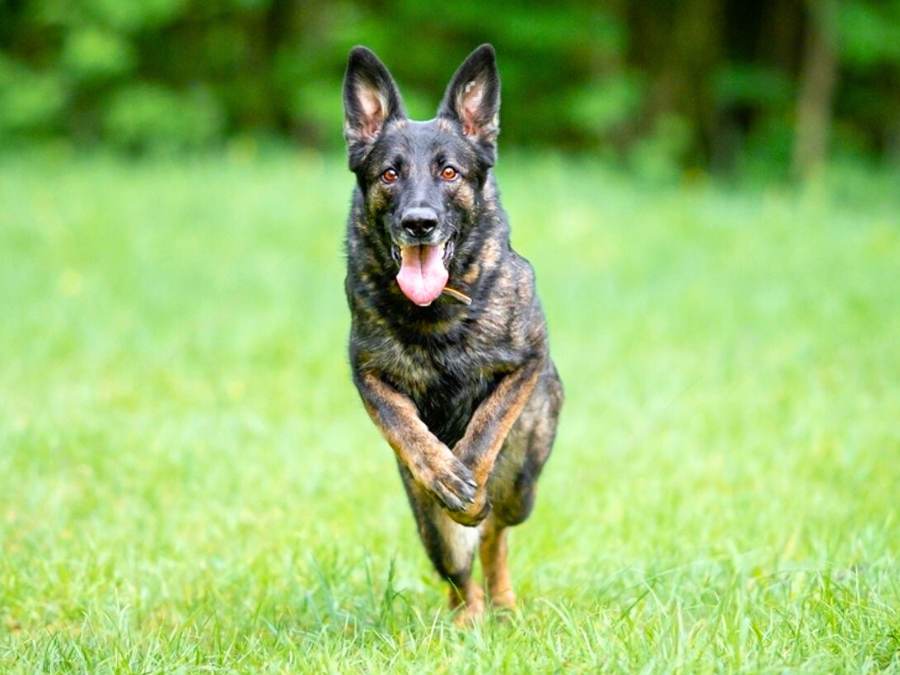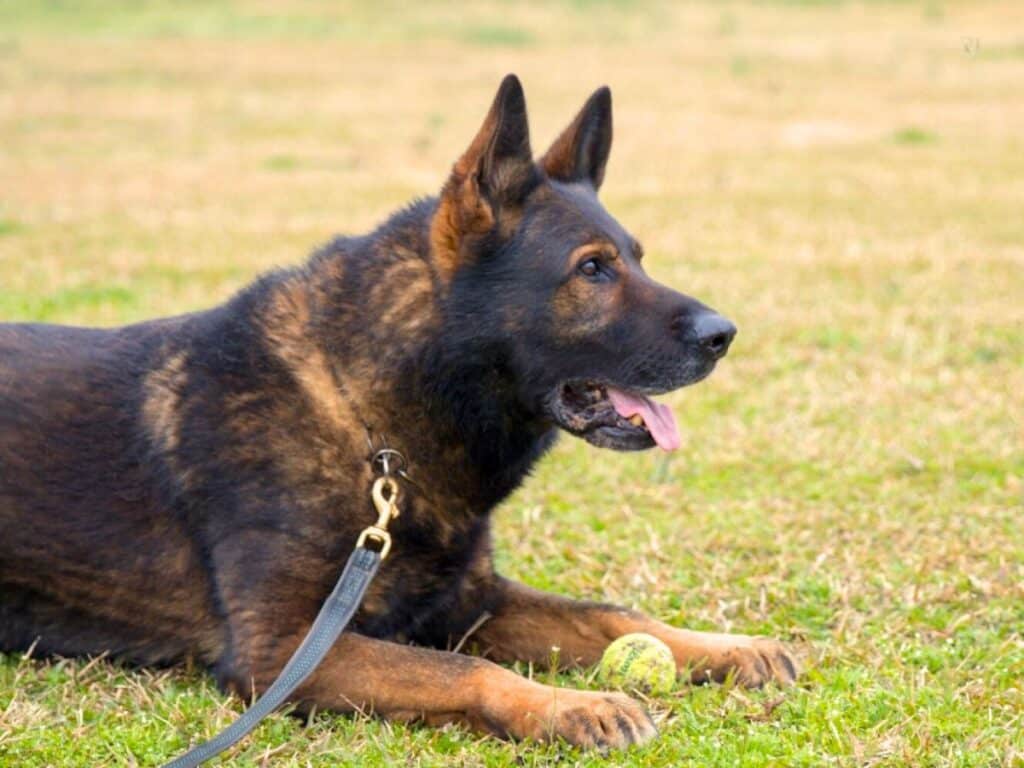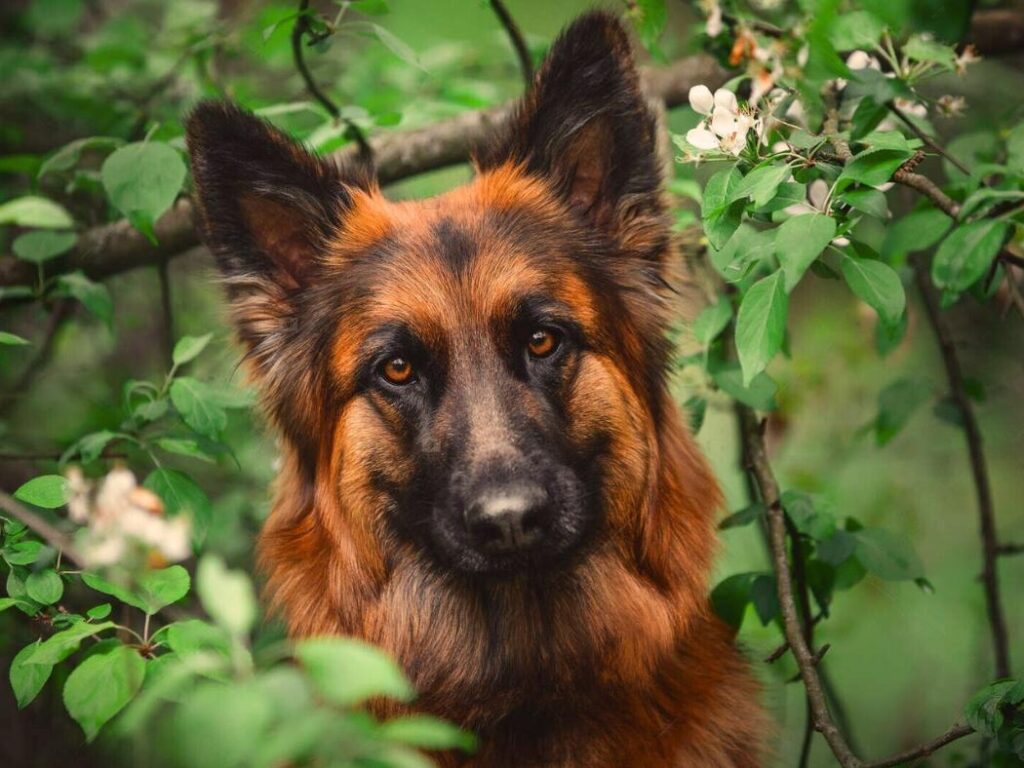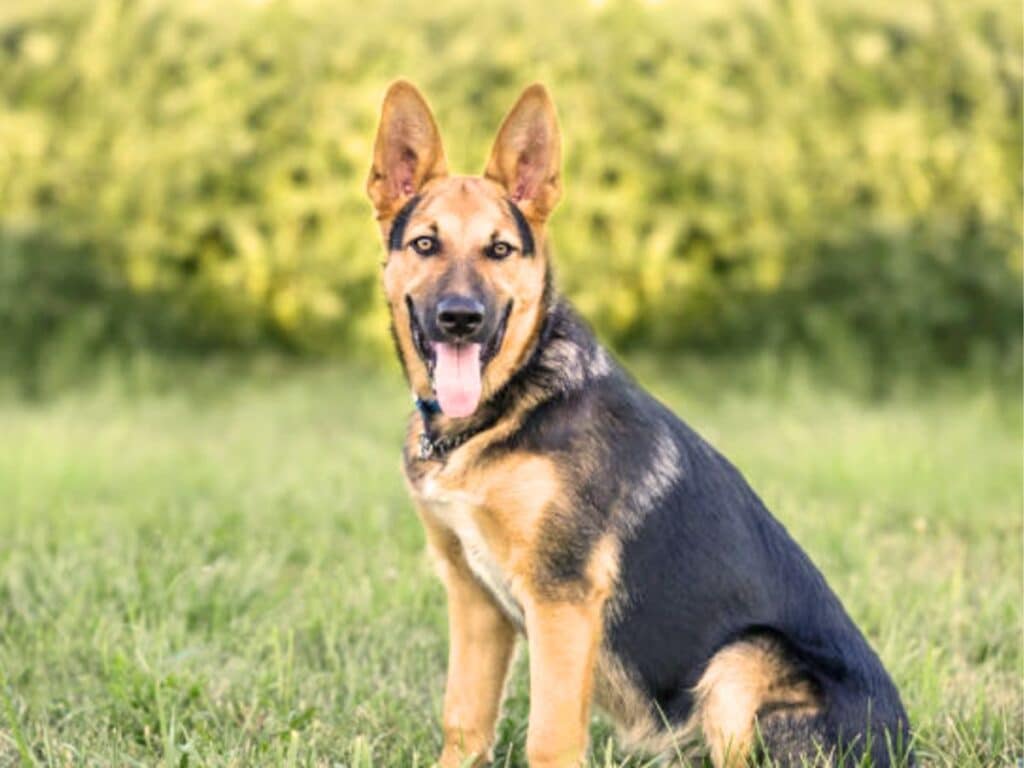The Sable German Shepherd is a variant of the German Shepherd breed that fits the breed founder’s ideal description of what a German Shepherd should look like.
The main difference between black and tan show-line German Shepherds and Sable GSDs is the difference in coat color.
Regular German Shepherds have more tan and light brown fur across their bodies. The fur of Sable GSDs on the other hand, has typically lighter roots with black tips that give them a wolf-like appearance.
What Are Sable German Shepherds?
Sable German Shepherds are a distinct color variation within the German Shepherd dog breed, known for their unique coat pattern.
The term “sable” refers to the coloration of their fur, which contains individual hairs that are multi-colored, typically with darker tips and a lighter base.
This gives the sable German Shepherd a shaded or gradient appearance, varying from light to dark across their body.

The color can range from a silver or gray tone to a reddish or brown shade, depending on the specific genes present in the dog.
This color variation is one of the most natural and historically significant within the breed, closely resembling the coloration of the German Shepherd’s wolf ancestors.
It’s important to note that sable is not a marker of a different breed, but rather a color variation within the standard German Shepherd breed.
Are Sable German Shepherds Recognized By The AKC?
Yes, the Sable-colored GSDs are recognized and accepted by major kennel clubs, including the American Kennel Club (AKC).
Are Sable German Shepherds Good Family Dogs?
Yes, Sable German Shepherds can be excellent family dogs. They are known for their loyalty, intelligence, and protective nature. With proper training and socialization, they can be affectionate and gentle companions, forming strong bonds with family members, including children.
Are Sable German Shepherds Suitable for First-Time Owners?
Sable German Shepherds can be a challenge for first-time dog owners due to their high intelligence, energy levels, and need for regular training and exercise. However, with commitment to proper training, socialization, and care, a first-time owner can successfully raise a well-behaved and happy Sable German Shepherd.

Sable German Shepherds vs Black & Tan German Shepherds
Most Sable German Shepherds are working line East German Shepherds or Deutsches Demokratische Republik (DDR) bloodlines. These dogs come from a bloodline of loyal and brave guard dogs bred in Germany following World War II.
Working line Sable German Shepherds and show line Black & Tan German Shepherds differ in several key aspects, largely due to the distinct breeding practices that emphasize different traits according to their intended roles.
Here’s a breakdown of the main differences:
Physical Appearance
Working Line Sable German Shepherds: These dogs are bred primarily for their working abilities rather than their appearance. The sable coloration, which can range from light to dark, is common in working lines due to its genetic roots in the breed’s ancestry.
Working line dogs may have a more athletic build with leaner muscles, designed for agility, endurance, and functionality. Their coat is often denser and more weather-resistant, suitable for various working conditions.

Show Line Black & Tan German Shepherds: Show line dogs are bred to meet specific breed standards for conformation shows, emphasizing physical traits like coat color, pattern, and body proportions.
Black & Tan is a popular and recognized color in show lines, characterized by a distinctive black saddle on the back and tan or cream markings elsewhere. These dogs often have a more angulated hindquarters and a more pronounced “stacked” appearance, which is favored in the show ring.
Temperament and Behavior
Sable GSDs: Sable German Shepherds are bred for traits such as high drive, intelligence, resilience, and a strong working ethic. They are often more energetic and require more mental and physical stimulation to stay happy and healthy.
Their temperament is suited for tasks such as police work, search and rescue, and protection, reflecting their strong instincts and versatility.
Black & Tan GSDs: While still intelligent and capable, show line German Shepherds may have a more subdued temperament compared to working lines.
They are bred with a focus on traits that make them excellent companions and show dogs, potentially resulting in a dog that is more relaxed and possibly better suited for a family environment.
Sable German Shepherd Overview
The table below offers a succinct overview of the Sable German Shepherd’s key characteristics, including physical attributes, temperament, health considerations, and their esteemed role in human society.
| Attribute | Details |
|---|---|
| Coat Color | Sable (each hair has a black tip, giving the coat a shaded appearance) |
| Size | Males: 24 to 26 inches at the shoulder; Females: 22 to 24 inches |
| Weight | Males: 65 to 90 pounds; Females: 50 to 70 pounds |
| Temperament | Intelligent, loyal, protective, and versatile |
| Trainability | High; eager to learn and responds well to positive reinforcement training |
| Exercise Needs | High; requires regular physical and mental stimulation |
| Health Concerns | Hip and elbow dysplasia, degenerative myelopathy, and gastrointestinal issues among the common ones |
| Lifespan | Approximately 9 to 13 years |
| Litter Size | 5 – 9 puppies |
| Suitable For | Active individuals and families; Work in police, military, search and rescue, and as service dogs |
| Grooming Needs | Moderate to high; requires regular brushing to manage shedding and maintain coat health |
| Socialization Needs | High; early and ongoing socialization is crucial for well-rounded behavior |
| Price | Pet quality Sable GSD can cost anywhere from $500 to $1,500. |

History and Origin
The German Shepherd breed was developed in Germany in the late 19th century, primarily by Captain Max von Stephanitz, who sought to create the ideal herding dog.
What many don’t realize is that the sable coloration seen in some German Shepherds today closely resembles the breed’s ancestors.
The sable coloration is due to a dominant gene that affects the distribution of color in the dog’s fur, resulting in each hair being tipped with black.
This genetic trait is one of the oldest in German Shepherds and was highly valued for the camouflage it provided in various working environments, from fields to forests.
Physical Appearance
Sable German Shepherds share the same robust and agile build as their counterparts in other colors. Males typically stand between 24 to 26 inches tall at the shoulder, while females are slightly smaller, standing between 22 to 24 inches.
Their weight can vary, generally ranging from 65 to 90 pounds for males and 50 to 70 pounds for females, reflecting their muscular and well-proportioned bodies.
The sable coat features a blend of colors, with each hair tipped in black, giving the coat a shaded appearance that can range from silver and light gray to darker hues like gold and liver.
The coat of a Sable German Shepherd can be of medium length or long, featuring a dense undercoat that provides insulation and a coarser outer coat that repels water and dirt.
Regular grooming is essential to maintain the coat’s condition and manage shedding, especially during seasonal changes when they shed more heavily.
RELATED: The Different German Shepherd Colors

Sable German Shepherd Temperament
The overall temperament of the Sable German Shepherd is akin to that of the breed as a whole, known for their intelligence, loyalty, and protective nature.
- Intelligent: Sable German Shepherds are known for their exceptional intelligence, making them quick learners and highly trainable for a variety of tasks and commands.
- Loyal: They exhibit a profound loyalty to their owners and families, forming strong bonds and showing a deep commitment to their human companions.
- Protective: Naturally protective, they are vigilant and can act as excellent watchdogs, always alert and ready to safeguard their home and loved ones.
- Versatile: Their adaptable nature makes them suited for various roles, from companionship to working roles in police, military, and service positions.
- Eager to Please: This breed is known for its desire to please its owners, which, combined with its intelligence, makes training a rewarding experience.
- Confident: With proper socialization, they display confidence in a range of situations, approaching new experiences with curiosity rather than fear.
- Active: They possess a high energy level, thriving on physical activity and mental stimulation to keep them engaged and content.
- Good with Children: When properly socialized, they can be good with children, showing patience and often becoming protective of the younger members of the family.
- Social with Other Pets: With early introduction and consistent socialization, they can coexist peacefully and even form bonds with other pets in the household.
- Alert: Their alertness makes them excellent at perceiving changes in their environment, quickly responding to new stimuli or potential threats.

Sable German Shepherd Price
The cost of a Sable German Shepherd Dog (GSD) can vary widely based on several factors, including the breeder’s reputation, the dog’s lineage, location, and whether the dog has been bred for specific qualities or certifications.
- Pet Quality Sable German Shepherds: For a sable GSD that is meant primarily as a companion animal rather than for show or breeding, prices can range from $500 to $1,500.
- Show Quality and Working Line Sable German Shepherds: Prices for a show quality or working line sable GSD, which come from a lineage of champions or have been bred for specific working capabilities, can typically start at around $1,500 and can go up to $3,000 or more.
Exercise Requirements and Mental Stimulation
Sable German Shepherds, like all German Shepherds, are a highly active and intelligent breed that thrive on regular exercise and mental stimulation.
Here’s what potential owners should consider:
- Daily Exercise: A minimum of one to two hours of exercise per day is essential for a Sable German Shepherd. This can include brisk walks, runs, hikes, and play sessions in a securely fenced area. They possess a natural stamina and will enjoy activities that keep them moving and exploring.
- Mental Stimulation: Mental exercise is as crucial as physical activity for this intelligent breed. Training sessions, puzzle toys, and interactive games that challenge their problem-solving skills can prevent boredom and destructive behaviors.

Sable German Shepherd Training & Activities
Training and engaging in various activities are crucial for the well-being and development of a Sable German Shepherd. Given their intelligence and energy, these dogs thrive in environments where they can learn, work, and play.
Starting training early is key to molding a well-behaved and sociable Sable German Shepherd. Basic obedience training, including commands like sit, stay, come, and heel, lays the foundation for a disciplined dog.
Due to their intelligence and eagerness to learn, Sable German Shepherds excel in advanced training and dog sports.
They are well-suited for agility training, tracking, flyball, and Schutzhund, a sport that tests their tracking, obedience, and protection skills. Such activities not only provide physical exercise but also mental stimulation, keeping them engaged and happy.
Diet and Nutrition
Given their active lifestyle and robust build, Sable GSDs have specific dietary needs that must be met to ensure they remain in peak condition.
Here are essential considerations for feeding a Sable German Shepherd:
- Balanced Diet: A high-quality, balanced diet rich in proteins, fats, carbohydrates, vitamins, and minerals is crucial. Proteins support muscle development and maintenance, while fats provide energy and help absorb vitamins. Carbohydrates offer additional energy, and vitamins and minerals support overall health and immune function.
- Portion Control: Given their propensity for activity, Sable German Shepherds require at least 1600 calories/day to match their energy expenditure. However, it’s important to avoid overfeeding, which can lead to obesity and associated health problems.
- Hydration: Adequate access to fresh water is essential for active dogs. Proper hydration supports digestion, nutrient absorption, and overall health.
- Avoid Human Food: While it might be tempting to share human food with your dog, many common foods can be harmful to dogs. Stick to high-quality dog food and consult with a veterinarian before introducing any new foods or supplements into their diet.
Check out this video of a sable German Shepherd puppy change coat color as it matures…
Common Health Concerns
When discussing common health issues in Sable German Shepherds, it’s important to understand that these concerns are generally applicable to the German Shepherd breed as a whole, regardless of coat color.
Here’s an overview of common health issues to be aware of:
- Hip and Elbow Dysplasia: A genetic condition common in larger breeds, where the joint does not fit together perfectly, leading to arthritis and pain.
- Degenerative Myelopathy: A progressive disease of the spinal cord, leading to weakness and paralysis in the hind legs.
- Gastrointestinal Issues: Including bloat (gastric dilatation-volvulus), which is a life-threatening condition requiring immediate veterinary attention.
- Allergies: Sable German Shepherds can suffer from various allergies, including food, environmental, and contact allergies, leading to skin irritation and other health problems.
- Epilepsy: A neurological condition that can cause seizures. It can be managed with medication under veterinary supervision.
- Panosteitis (Growing Pains): A temporary condition in puppies and young dogs, causing lameness and pain in the legs.
- Exocrine Pancreatic Insufficiency (EPI): A condition where the pancreas fails to produce enough digestive enzymes, leading to malnutrition and weight loss despite a normal appetite.
- Skin Conditions: Including hot spots and dermatitis, often triggered by allergies or parasites.
- Eye Problems: Eye conditions such as infections, pannus, and progressive retinal atrophy, which can lead to vision loss if not treated early.
The life expectancy of a healthy Sable German shepherd is between 9 – 13 years.
RELATED: How Long Do German Shepherds Live?
Summary
For those considering bringing a Sable German Shepherd into their lives, it’s important to remember the commitment required to ensure their health and happiness. In return, they offer companionship, protection, and unconditional love, making them an unforgettable part of any family or individual’s life.
Frequently Asked Questions
1. Are sable German Shepherds rare?
Sable German Shepherds are not rare, but their unique coat color is less common than the traditional black and tan or all-black varieties, making them somewhat unique among the breed.
2. Are sable German Shepherds smaller?
No, sable German Shepherds are not smaller. They typically match the breed standard for size, with variations in height and weight similar to other German Shepherd color variations.
3. Are sable German Shepherds purebred?
Yes, sable German Shepherds are purebred. The sable coat color is one of the original color patterns recognized within the German Shepherd breed.
4. Are sable German Shepherds working lines?
Yes, most Sable German Shepherds are working lines but they excel in various roles, including work and companionship.
5. Are sable German Shepherds more aggressive?
No, sable German Shepherds are not inherently more aggressive. Temperament is influenced more by individual genetics, training, and socialization rather than coat color.
6. Are sable German Shepherds more expensive?
Sable German Shepherds can be more expensive than some other color variations, primarily due to the unique and desirable nature of their coat color, but prices can vary widely depending on lineage and breeder.
7. Do sable German Shepherds get darker with age?
The coat color of sable German Shepherds can change as they age, with some individuals becoming darker or lighter. This change is more noticeable in the first few years of life and can vary from dog to dog.
8. Are sable German Shepherds healthy?
Sable German Shepherds, like all German Shepherds, are generally healthy but can be predisposed to certain genetic health issues common to the breed, such as hip and elbow dysplasia, and degenerative myelopathy.
FURTHER READING:




